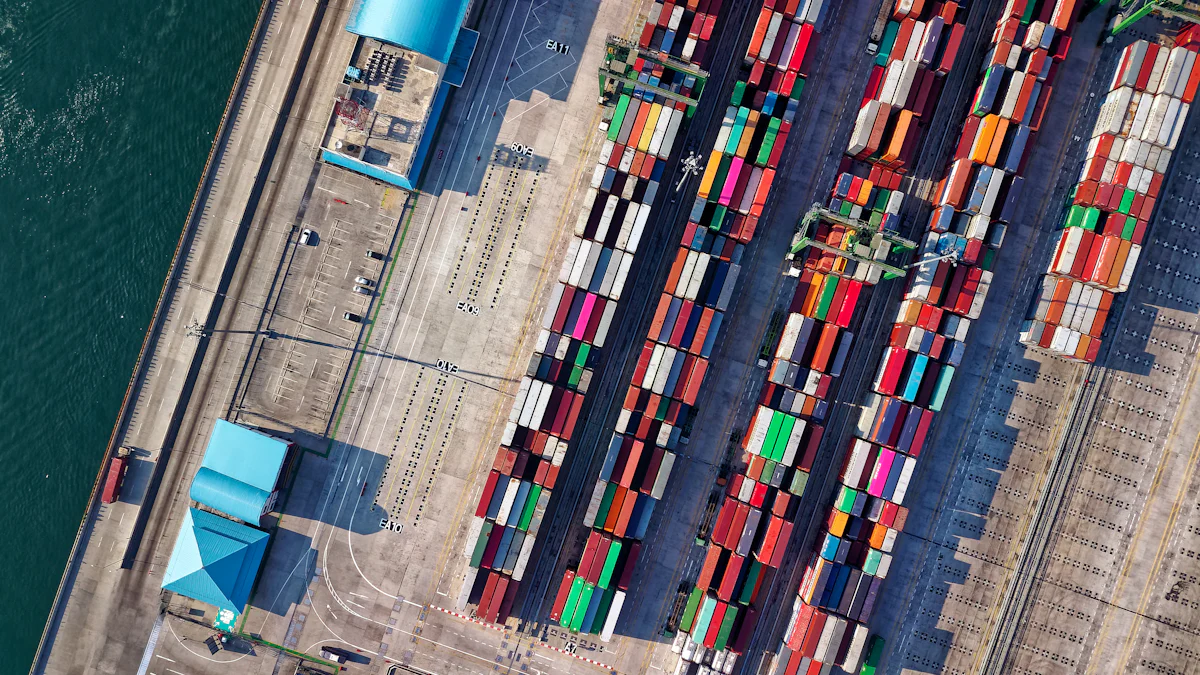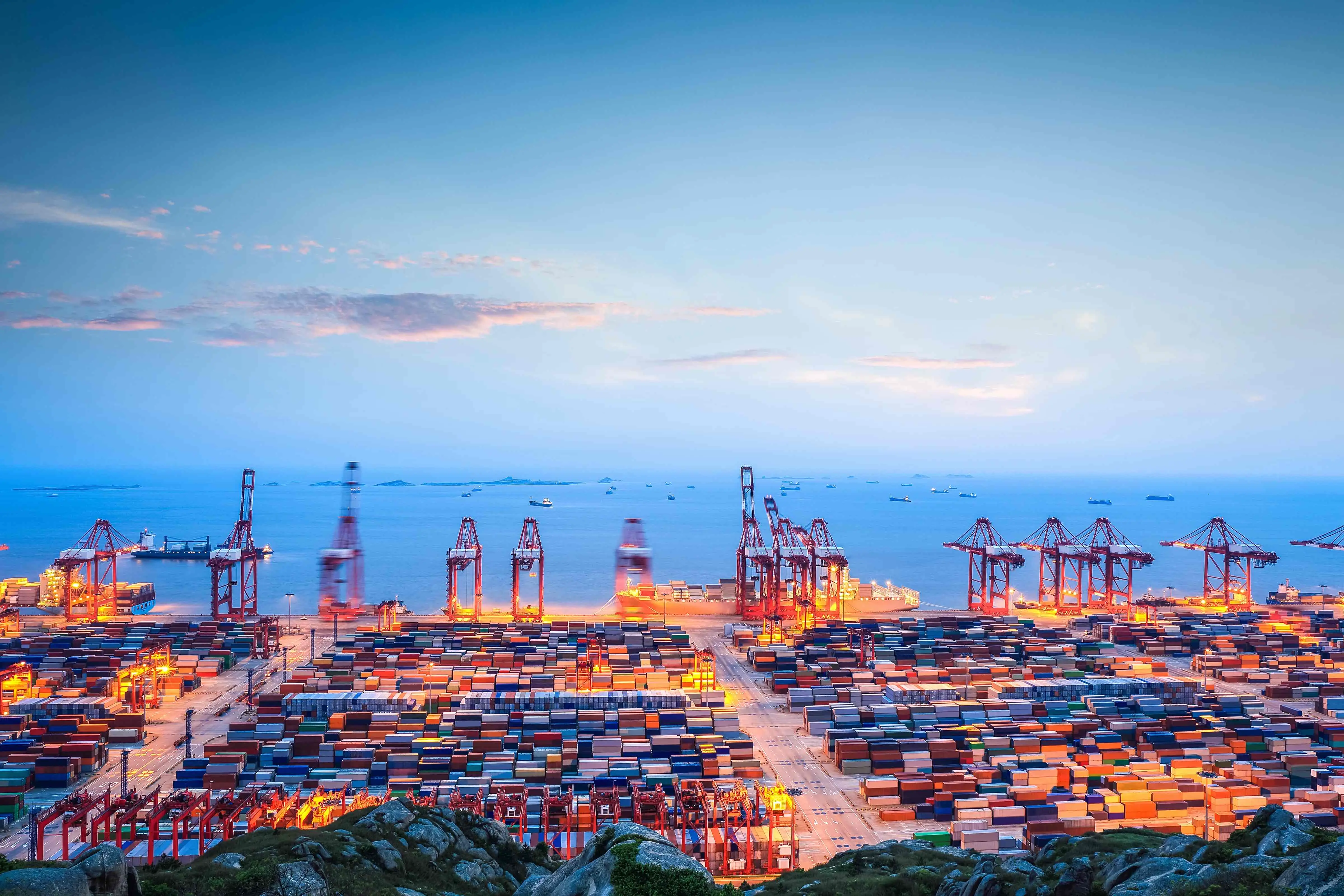Supply Chain Innovations to Watch in 2025

The supply chain industry is evolving rapidly. By 2025, over 75% of companies will adopt AI, IoT, and automation to enhance efficiency. Real-time data will transform decision-making, reducing costs and improving cash flow. Diversified sourcing strategies and upskilled teams will further drive operational resilience and competitiveness in this dynamic landscape.
Key Takeaways
Use AI and IoT tools to improve work and decisions in supply chains.
Train workers to give them skills for today’s supply chain jobs.
Focus on being eco-friendly to meet customer and law needs.
Key Supply Chain Trends to Watch in 2025
AI Integration for Predictive Analytics and Optimization
AI is revolutionizing supply chain management by enabling predictive and prescriptive analytics. You can use AI to anticipate future demand and optimize operations. For example, AI analyzes real-time data to adjust transportation routes based on traffic, weather, and inventory conditions. This technology also provides insights into inventory optimization, helping you reduce downtime and improve manufacturing efficiency. By 2025, companies investing in AI will gain a competitive edge by streamlining processes and enhancing decision-making.
Enhanced Risk Management Strategies for Resilient Supply Chains
Building resilience in supply chains has become essential. You can leverage technologies like AI, IoT, and blockchain to predict disruptions, monitor goods in real time, and ensure transparency. Proactive risk assessment, diversifying supplier networks, and maintaining safety stocks are critical strategies. Skilled professionals also play a vital role in managing risks effectively. These approaches help you navigate geopolitical and economic challenges while maintaining operational efficiency.
Last-Mile Delivery Technologies and Drones
Last-mile delivery is evolving with advancements like drones and autonomous vehicles. Retailers are adopting these technologies to improve delivery speed and adaptability. Big data analytics and route optimization tools enhance efficiency and customer satisfaction. IoT and blockchain further improve tracking and trust in logistics. By embracing these innovations, you can reduce costs and meet growing consumer expectations.
ESG Efforts Driving Sustainable Supply Chain Management
Sustainability is no longer optional. Governments and consumers demand accountability, pushing companies to adopt ESG initiatives. You can invest in data-integrated solutions to monitor resource consumption and comply with regulations. Responsible sourcing and ethical practices are essential for reducing environmental impact. By prioritizing ESG efforts, you align with emerging supply chain trends and build trust with stakeholders.
Emerging Technologies Transforming Supply Chain Management

Generative AI for Demand Forecasting and Decision-Making
Generative AI is reshaping how you approach demand forecasting and decision-making in supply chains. By analyzing historical sales data and market trends, it predicts future demand with remarkable accuracy. This technology helps you optimize inventory levels, reducing the risk of stockouts or overstocking. Generative AI also empowers you to explore various demand scenarios, enabling quick adjustments based on real-time "what-if" analyses. For example, it identifies patterns traditional models might miss, giving you a competitive edge in planning and resource allocation. By 2025, businesses leveraging generative AI will make smarter, data-driven decisions that enhance operational efficiency.
IoT for Real-Time Tracking and Visibility in Supply Chains
The Internet of Things (IoT) provides you with real-time visibility into your supply chain. IoT sensors track the location and condition of goods, ensuring you can respond quickly to disruptions. This technology also monitors storage conditions, maintaining product quality during transportation. By automating processes like predictive maintenance and route optimization, IoT reduces costs and boosts productivity. Additionally, real-time tracking improves customer satisfaction by enhancing transparency. With IoT, you can manage risks proactively and optimize supply chain operations through advanced data analytics, making your networks more resilient and efficient.
Blockchain for Transparency and Fraud Prevention
Blockchain technology offers you a secure way to enhance transparency and prevent fraud in supply chains. It creates an immutable record of transactions, ensuring all parties access the same data. This reduces the risk of manipulation and builds trust across your supply chain. Blockchain also enables end-to-end traceability, allowing you to track goods in real time. For example, it ensures the authenticity of products by verifying their origins. By adopting blockchain, you can improve accountability and streamline operations, making your supply chain more reliable and secure.
Automation and Robotics in Warehousing and Logistics
Automation and robotics are transforming warehousing and logistics. Automated guided vehicles and autonomous mobile robots handle tasks like picking, packing, and sorting with precision. These technologies increase efficiency and reduce operational costs. Collaborative robots, or cobots, work alongside human workers, enhancing productivity without replacing jobs. Cloud-based warehouse management systems provide real-time inventory tracking, ensuring you maintain optimal stock levels. By integrating artificial intelligence and machine learning, you can further improve warehouse operations. As the global warehouse automation market grows, these advancements will play a crucial role in modernizing supply chains by 2025.
Sustainability and Circular Supply Chain Models

Recycling and Reusing Materials to Reduce Waste
Recycling and reusing materials play a vital role in creating a sustainable supply chain. You can reduce waste by using recycled materials in your products, which conserves natural resources and lowers the demand for virgin materials. Designing products that are easy to repair or remanufacture extends their lifespan and minimizes waste generation. Offering product take-back programs allows customers to return items at the end of their life cycle, enabling you to recycle or reuse them effectively. Collaboration among stakeholders also supports closed-loop practices, ensuring waste materials are reintegrated into production. By adopting these strategies, you contribute to a circular economy that reduces environmental impact.
Carbon Footprint Reduction Through Green Logistics
Green logistics focuses on minimizing the environmental impact of supply chain operations. Sustainable transportation solutions, such as eco-friendly vehicles and optimized routes, significantly reduce emissions. Energy-efficient warehousing lowers energy consumption by using renewable energy sources and efficient lighting systems. Sustainable packaging further reduces waste and the carbon footprint associated with production and disposal. By implementing these practices, you address major contributors to carbon emissions in logistics. Planning and managing logistics with sustainability in mind not only benefits the environment but also enhances operational efficiency.
Renewable Energy Adoption in Supply Chain Operations
Adopting renewable energy in supply chain operations offers multiple benefits. It ensures compliance with emissions standards, helping you avoid penalties under carbon taxation schemes. Energy-efficient practices improve resource utilization and reduce fuel costs, boosting operational efficiency. Diversifying energy sources enhances resilience, allowing you to adapt to economic and environmental challenges. Meeting consumer demand for sustainability strengthens your brand reputation and market position. For example, using solar or wind energy in warehouses and transportation reduces reliance on fossil fuels. By integrating renewable energy, you future-proof your operations and align with the sustainability goals of 2025.
Preparing for 2025: Actionable Steps for Supply Chain Management
Investing in Workforce Training and Upskilling
Preparing your workforce for the future is critical. Training employees in data collection and analysis, AI, and machine learning equips them with skills essential for modern supply chain roles. Upskilling also enhances capabilities in cybersecurity and sustainability, aligning with organizational goals. Continuous learning ensures your team adapts to evolving supply chain trends and disruptions. By investing in training, you empower supply chain professionals to handle advanced technologies like automation and AI, improving operational efficiency and resilience.
Adopting Agile and Flexible Supply Chain Models
Agility in supply chain management allows you to adapt quickly to market changes. Flexible models improve operational efficiency by streamlining workflows and reducing inventory carrying costs. Smaller batch sizes and frequent deliveries lower risks of overproduction and enhance cash flow. Agile networks also enhance customer experience by responding to demand fluctuations and reallocating resources effectively. By adopting these models, you reduce waste, optimize resources, and strengthen supply chain visibility and forecasting.
Allocating Resources for Technology Upgrades
Investing in technology upgrades ensures your supply chain remains competitive. Automation and AI tools enhance efficiency by automating repetitive tasks and improving decision-making. IoT devices provide real-time visibility into inventory and transportation, reducing disruptions. Blockchain technology strengthens transparency and prevents fraud. Allocating resources to these innovations helps you stay ahead of supply chain trends while improving productivity and reducing costs.
Building Stronger Supplier Relationships
Strong supplier relationships are vital for a resilient supply chain. Drafting clear contracts and ensuring timely payments build trust and maintain good cash flow. Treating suppliers as partners fosters collaboration and reduces misunderstandings. Using technology to enhance visibility and efficiency in interactions strengthens these relationships further. A dedicated supplier relationship management team can oversee these efforts, ensuring long-term success.
JUSDA’s Role in Shaping Future Supply Chain Trends
Leveraging JusLink for Real-Time Supply Chain Collaboration
JusLink, JUSDA's intelligent supply chain platform, empowers you to achieve seamless collaboration across your logistics network. It integrates advanced technologies like IoT and AI to provide real-time tracking and dynamic control. This platform enhances visibility, allowing you to monitor every stage of your supply chain with precision. For example, JusLink enables smart forecasting and replenishment, improving accuracy by 78% and boosting inventory turnover. By adopting JusLink, you can streamline operations, reduce risks, and make data-driven decisions that align with future logistics demands.
JUSDA’s Warehouse Solutions for Optimized Inventory Management
JUSDA's warehousing solutions redefine how you manage inventory. With dynamic inventory management systems and automation, these solutions minimize manual errors and improve productivity. JUSDA's warehouses, equipped with technologies like eVMI and JusLink, offer real-time inventory tracking and control. This ensures transparency and reduces costs. For instance, automation in warehousing accelerates processes like picking, packing, and sorting, enabling you to meet customer demands efficiently. By leveraging these innovations, you can optimize inventory levels and enhance operational efficiency.
Industry-Specific Supply Chain Innovations by JUSDA
JUSDA tailors its supply chain solutions to meet the unique needs of various industries. Its digital tools, such as auto procurement and risk management systems, address specific challenges in sectors like automotive, electronics, and FMCG. The JusLink platform provides end-to-end visibility, helping you adapt to market changes quickly. For example, a global industrial company used JusLink to optimize its supply chain performance, achieving significant improvements in accuracy and inventory turnover. These innovations position JUSDA as a leader in shaping industry-specific logistics strategies.

JUSDA Solutions
To provide you with professional solutions and quotations.
The supply chain industry is entering a transformative era in 2025. You can gain a competitive edge by embracing technology, sustainability, and strategic partnerships.
Key Takeaways:
Investment in technology optimizes processes and reduces costs.
Upskilling your workforce ensures adaptability to new roles.
Sustainability aligns business goals with ecological benefits.
JUSDA’s solutions, like JusLink, empower you with real-time insights and automation. These tools enhance efficiency, reduce risks, and position your business for success in this evolving landscape.
🌟 By adopting these innovations, you future-proof your operations and thrive in a dynamic global market.
See Also
Exploring 5 Key Trends Shaping Supply Chain Efficiency
Enhancing Supply Chain Performance Through AI Innovations
Discover 5 Cutting-Edge Techniques for Supply Chain Optimization
Transforming Logistics With Innovative Supply Chain Solutions
